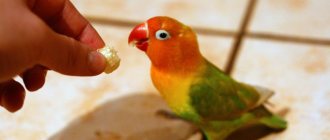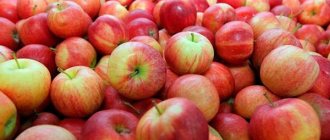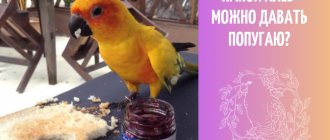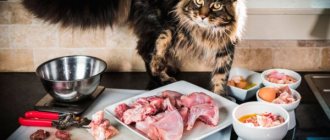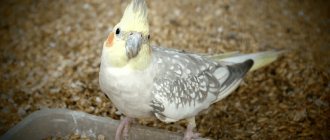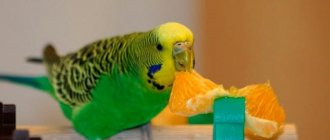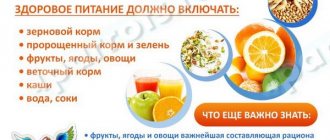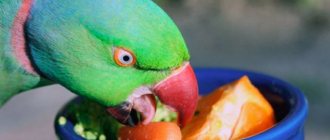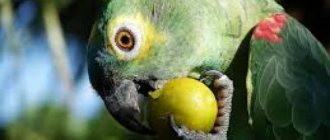Packaged and ready-to-eat bird food, although a good basis for the diet, should not become the pet’s only nutrition. Most experienced owners and breeders strongly recommend adding fruits and treats - this is both beneficial and enjoyable. There are many options for vitamin feeding; many are interested in whether it is possible to give tangerines to a parrot, since this fruit is in stores all year round, and in the autumn-winter period it remains the most affordable.
Can a parrot have tangerines?
Citrus fruits are part of the natural diet of many species of parrots. These fruits contain a large number of useful nutrients, therefore, even if the wild relatives of a particular species of parrots do not feed on tangerines in nature, giving them to pets in captivity is not only possible, but also necessary. The beneficial elements contained in the fruits are easily absorbed by the bird's body. If you avoid overfeeding, citrus fruits will not cause digestive disorders or allergies. If you give a variety of fruits, including tangerines, your parrot does not need to introduce artificial vitamin supplements into its diet.
Lemon, grapefruit
Fresh lemon peels prevent the formation of gases in the intestines, cleanse the intestines and blood, and tone the body. They are good to use to improve digestion. All these properties apply not only to the peel, but also to the partitions. This is especially true for grapefruit. It is necessary to choose fruits with a smoother peel, because less porous peel contains more fiber and vitamins.
It is better to offer birds fresh citrus fruits along with the peel. Grated zest can be added to sprouts, porridges, and salads. The dry peel is convenient for “pickers” and for making chewing toys.
An example of a dry scoop feeder: in addition to dried citrus peels (lemons, oranges, tangerines, pomelo, bergamot, lime), tomato stems, green fruit peels, various seeds (including citrus fruits), zucchini, eggplant, and beet peels are also used here , carrots, watermelon, melons, dry eucalyptus leaves, mimosa flowers, nut shells, etc.
Do budgies like tangerines?
Many novice bird owners are interested in whether budgies can eat tangerines. These citrus fruits are not included in the natural diet of budgerigars, however, in captivity, representatives of this species successfully eat this exotic food. These fruits are juicy and sweet in taste, so they are usually very popular with birds. However, many birds are wary of new types of food, so they may hesitate to try an unusual food for a long time. In this case, you should leave the treat in the cage for a while so that the parrot gets used to its unusual appearance and smell. You can set your own example for the bird by eating a tangerine in front of the cage. Another way to get used to healthy food is to add a small amount of tangerine pulp to the usual food, gradually increasing the proportion of citrus. If your budgie categorically does not like tangerines, you should replace them with other fruits or try again later.
Cucumbers, cabbage, pears, apples, potatoes, peppers, berries
Cucumber peel contains incomparably more vitamins than the pulp.
Cabbage does not have a peel, but what is interesting is that its outer leaves contain much higher levels of all vitamins and microelements than their inner leaves. Meanwhile, we constantly throw them out, “stripping” the cabbage before the cooking process.
Bean pods, as well as pea and mung bean pods, contain more vitamins than a scattering of seeds. True, the pods contain less protein, but the amount of fiber is disproportionately greater.
But in apples, pears and potatoes - on the contrary - there are fewer essential vitamins in the peel than in the pulp. But even in the pulp they are distributed unevenly - closer to the core their concentration increases. Therefore, those who are accustomed to eating pears and apples with seeds, without leaving so-called cores, nourish their body more intensively. However, apple peel has some magical properties, but more on that next time.
An article about the importance of fruit seeds for parrots.
And the most interesting thing. In tomatoes and sweet bell peppers, the concentration of vitamins decreases from the base to the top. That is, there are more vitamins in the part of the fruit where it is attached to the plant, we are used to calling this place “the butt,” and, again, we cut it off very often.
Dried peel: zucchini, eggplant, beets, carrots, watermelon, melon, potatoes, bell peppers.
The peel of the berries contains many vitamins and cellulose (fiber) that birds need so much. Do not throw away the peels of exotic fruits (mango, kiwi, lychee, pineapple). Dry it. In dry form, it will perfectly complement the composition of dry feeders for all types of parrots.
The gray parrot digs into the feeder-digger with pleasure. Pomegranate peel, as seen in this photo, is well eaten by grays, as are dry citrus peels.
What are the benefits of tangerines?
Tangerines contain many useful substances necessary for the proper functioning of the body:
- vitamin C – increases immunity and the body’s resistance to adverse environmental influences, strengthens the walls of blood vessels;
- vitamin A and carotenoids – improve visual function, the condition of the skin, beak, claws and feathers, as well as mucous membranes;
- vitamin B1 – maintains the health of the nervous system, participates in metabolic processes;
- vitamin B2 – participates in the formation of red blood cells and antibodies, maintains the health of the skin and its derivatives, normalizes the function of the thyroid gland and reproductive system;
- vitamin B6 – essential for the health of the nervous system and skin;
- vitamin E – has a beneficial effect on reproductive function;
- vitamin PP – promotes wound healing, normalizes metabolic processes;
- potassium – necessary for the functioning of the heart muscle;
- calcium – participates in the process of bone tissue formation;
- sodium – maintains water balance in the body;
- magnesium – participates in the transmission of nerve impulses and muscle contraction;
- phosphorus – regulates hormone levels, ensures the functioning of muscles, kidneys, liver and nervous system;
- iron – is part of hemoglobin, participates in metabolic processes, strengthens the immune system.
In addition, tangerines are a source of sugars, organic acids and fiber. Sugars and organic acids are necessary for the formation of energy, and fiber is necessary for the proper functioning of the digestive system.
Pomegranate
Another product undeservedly included in the “prohibited” lists due to the high content of tannins. The bird's body's need for tannin has already been discussed in the article:
“What to feed a parrot? Tannins are an essential component of a parrot’s diet.”
What else is pomegranate peel good for the bird’s body, besides tannin? The chemical composition of pomegranate peel is of particular interest, since it contains a very large number of macro- and microelements. The peel contains: choline, potassium, manganese, cobalt, calcium, magnesium, iron, zinc, copper, silver, selenium, nickel; in addition: tannins, ursolic acid, lysine, valine, leucine, phenylalanine, threonine, pigments, vitamin E and B vitamins, as well as antioxidants. Pomegranate peel has a number of beneficial properties, including antioxidant, astringent, anti-inflammatory, antimicrobial, and wound-healing properties.
Pomegranate and citrus peels prepared for drying.
Pomegranate peel is a real boon for the intestines of birds and more. Thanks to its qualities, pomegranate peel helps fight against enteritis, which is NOT uncommon in birds. Here's the latest research on the benefits of pomegranate peel:
British scientists from Kingston University have found properties in pomegranate peel to treat antibiotic-resistant staphylococcus and other common infections. Research has found that when combined with two other natural products - metal salts and vitamin C - the anti-infective effectiveness of pomegranate components increased significantly. Doctors have developed an ointment from this composition, which, according to them, can successfully attack drug-resistant microbes.
Laboratory testing was carried out using microorganisms such as methicillin-resistant Staphylococcus aureus. This type of staphylococcus is an important pathogen and agent that provokes the development of an infectious disease, which is difficult to combat due to the resistance of bacteria to antibiotics. Recently, doctors are increasingly identifying infections that are mutating towards drug resistance. An ointment based on pomegranate extract, without any obvious side effects, most effectively and quickly helped cope with bacteria.
All this suggests that often, out of ignorance, we deprive our feathered pets of a very important and vital part of the diet, causing very significant damage to the bird’s health. Pomegranate peel should be present in the bird's diet. It is easy to prepare for future use and use by adding it to the composition of “mowers”.
How to properly feed a parrot with tangerines
No matter how healthy tangerines are, they should not become the basis of a parrot’s diet. Fruit should be given in small quantities as a treat. Large species of birds are allowed to produce no more than 2 fruits per week, small and medium-sized ones - no more than 1-1.5. If there is an excess of citrus fruits in the diet, the bird may develop allergies or hypervitaminosis. The acid contained in citrus fruits, when fed in large quantities, causes irritation of the mucous membranes of the digestive tract. In addition, individual intolerance to the product is possible. Therefore, a new type of food should be introduced into the diet gradually. The parrot is given a small piece and their body’s reaction is monitored. If the product is well tolerated and there are no changes in the appearance or behavior of the bird, you can gradually increase the dose, bringing it to the daily norm.
On a note! To feed parrots, choose ripe citrus fruits without rot or mold. The fruit should have an even orange peel without damage. After purchasing, the fruits must be washed.
Mandarin oranges are given to parrots peeled. Citrus peels contain large amounts of essential oils that are harmful to birds. In addition, fruits are treated with chemicals during cultivation, transportation and storage to protect them from pests. Toxic compounds accumulate in the peel and can poison the bird. The films between the slices are removed so that the parrot does not choke. The bones are also removed and only the pulp is fed to the bird.
What else to include in your diet for a balanced diet
Not only people, but also other living creatures have individual taste preferences, and parrots are no exception. It is quite possible that your particular feathered friend will not appreciate the taste of tangerine and will simply refuse such a treat.
There is nothing wrong with this - to replenish the bird’s body with the necessary vitamins and minerals, you can include other natural treats in its diet, not necessarily exotic ones, for example:
- apples, pears (the seeds must be removed, the peel, if there is no doubt that the fruits have not been subjected to chemical treatment, can be left);
- grapes (you can use both white and black, but black is much healthier; you don’t need to remove the seeds from these berries);
- any seasonal berries (parrots happily peck strawberries and wild strawberries, raspberries and gooseberries, blueberries and blueberries, red, black and white currants, etc.);
- cherries, plums, apricots, peaches (we first remove the pits and leave the skin on);
- melons and watermelons (pulp, maybe with seeds, but since these berries often contain a lot of nitrates, you should first try this delicacy for yourself);
- kiwi (pulp with seeds, peel);
- bananas - only ripe, yellow ones (pulp and peel removed);
- pineapple (only the pulp, peel and core are removed);
- mango, papaya (pulp);
- other types of citrus fruits - orange, grapefruit, kumquat, pomelo, etc. (given in the same way as tangerines).
Any fruit should be thoroughly washed before giving it to your parrot. In summer, it is best to give your bird seasonal fruits, while exotic delicacies are more suitable for the cold season.
In addition, fruits can be dried or frozen for the winter (in the latter case, before consumption, they must be removed from the freezer and left at room temperature until completely defrosted and not cold).
Important! Candied fruits should not be given to parrots! Unripe fruits are also contraindicated for birds. The main danger in this regard are exotic new products that appear on our shelves obviously green, however, having no idea what they should actually look like, we often mistake them for ripe.
If the parrot categorically refuses any fruit (this often happens when purchasing an adult bird that is accustomed to meager and monotonous food and does not want to experiment), you can try to cheat.
Video: how to teach a parrot to eat vegetables and fruits For example, you can change the form of serving - instead of a small piece, give a large one, grind the pulp into puree, squeeze out the juice, prepare a mix with food already known to the parrot, etc. By the way, vitamin A is the best thing for a parrot’s body absorbs specifically from carrot juice, while no more than 1% of the total beta-carotene contained in a piece of carrot eaten by a bird will be absorbed.
We recommend reading about why a parrot constantly screams, and also find out what to do if the feathered pet is afraid of its owner.
Serving a new delicacy can also be included in the game, turned into fun entertainment, which all parrots are great hunters for. Pieces of fruit are strung on skewers, adapted to the bird’s favorite toys, placed in its favorite corners of the cage - in a word, the field for the manifestation of imagination is unlimited.
And don’t forget about your own example: watching with what appetite the beloved owner devolves some strange thing, a curious bird may well become eager to take part in the process. Mandarin orange is a source of almost all the vitamins, minerals and amino acids that a parrot needs.
Therefore, it is possible and necessary to include this fruit in your pet’s diet, unless the bird has an individual intolerance to the components contained in the product.
Did you know? The ancient Chinese mystical teaching about the harmony of man and the universe, the famous Feng Shui, considers a parrot in the house as a source of joy, positive emotions, laughter, good luck, prosperity and prosperity. But besides this, the parrot symbolizes wisdom, and therefore, when it enters a house, it motivates its inhabitants to spiritual growth, expansion of consciousness and self-improvement.
But if for some reason the parrot refuses the treat, it doesn’t matter: in addition to tangerine, there are many other fruits and berries that are no less useful for the bird, which it may like much more.
Feeding during illness
The basic rule to follow when your pet gets sick is to reduce the amount of food. The parrot itself will eat less. This is due to the fact that the bird’s body spends all internal resources on overcoming the disease, and not on digestion. But you can help your pet - give him already prepared foods - porridge, boiled vegetables. And follow your veterinarian's recommendations.
Reviews from the network
We heard that parrots should produce fruit, especially citrus fruits, so we decided on orange. We picked it out, we removed all the bones, membranes, etc. It looked like it tasted good, so we started giving it other things - tangerines, apples, various berries, strawberries, cherries. We tried to serve lemon to our parrot, but she didn't like it and we didn't insist. Apparently they like it sweeter. However, we are careful not to overdo it - too much sugar is bad for people and birds.
Tangerines, oranges and other fruits contain many useful substances. In small quantities and properly prepared by the body, the parrot will not bring it exactly. In this case, only the peels and seeds are not safe and are easy to get rid of. Floating, however, the animal will be happy to eat.
What fruits and berries can be given
All parrots, like people, have different food preferences. Some people may not like tangerines or oranges. In this case, you should offer your animals Other options:
Watermelons, melons, kiwis, pineapples will work from these exotic ones. Only flesh, no skin or seeds. It is better not to offer only one product, but constantly change it into another. Be careful when shopping - stores often provide unripe produce that has already been ripe on the counter; They are dangerous for feeding birds.
Dried or frozen fruit can be kept in reserve. Let them sit until they reach room temperature before serving. Serve candied fruit parrots because they contain too much sugar. Dried fruits are allowed, such as apricots or plums. Firstly, it is flooded with boiling water and left for half an hour to become softer.
